We are finally coming up for air after the One Room Challenge and Thanksgiving. Time seemed to vaporize right in front of us for a few days. Before we move onto new projects, here is the floor stenciling tutorial that I promised. So many of you liked and commented on the floor in the breakfast nook. This high impact project pulled all of the architectural elements and the decor details of our ORC room together. In essence, it was the glue of our design.
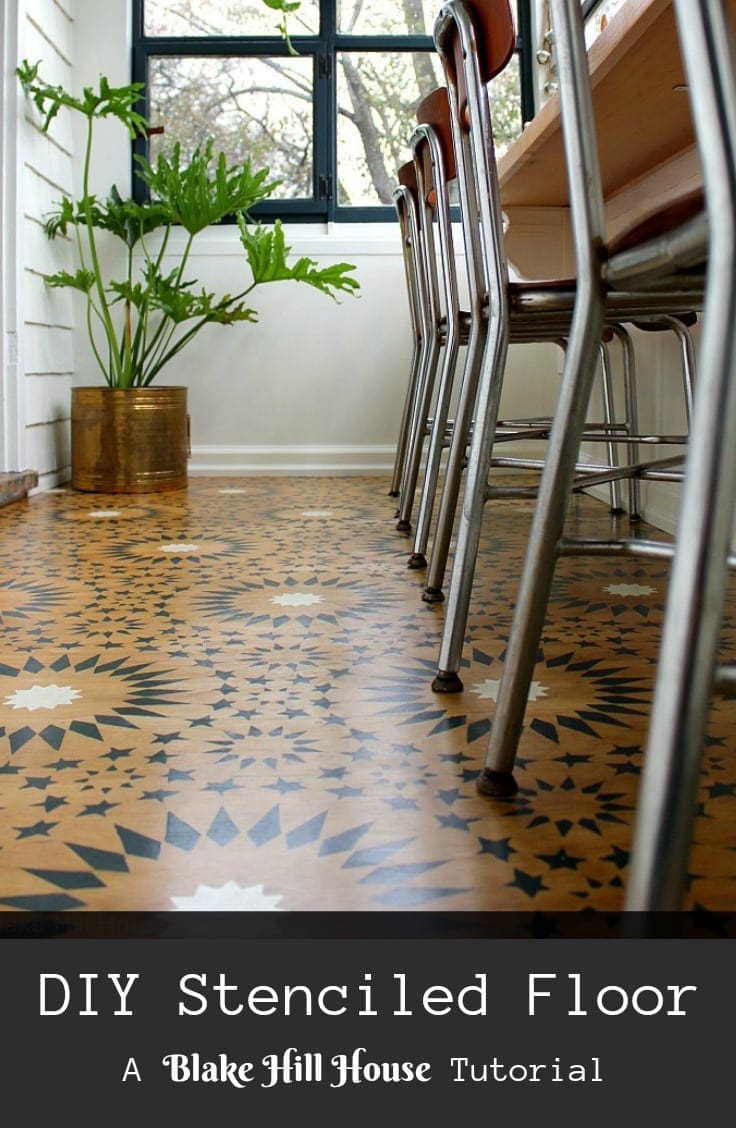
The process of stenciling is reasonably simple and straightforward, but it does require time. Due to its low difficulty rating (based on our subjective BHH scale!), I have added this tutorial to our DIY Basics series.
Before I begin, I need to give credit where credit is due. The original idea for this floor came from Weaber Lumber located in Lebanon, PA. I saw this image on Instagram, and I fell in love, with the floor, not the guy, just to be clear.
All the color choices, opinions, and tips are my own. If you need to lay a plywood floor first, we wrote a post about that too. And if plywood floors are not your thing, feel free to stencil directly onto the flooring of your choice. The only difference will be prep, and I address that below.
Helpful Links & Resources
This post contains affiliate links.
For our project, we used the Ambrosia Moroccan Tile stencil from Cutting Edge Stencils. While we have worked in partnership with Cutting Edge Stencils before, the breakfast nook floor project was all out-of-pocket. Cutting Edge Stencils has an extensive video and printable tutorial library. Before you begin your project, watch the videos, and read and download their basic stenciling instructions. I typed that in boldface because if you are anything like me, you will want to skip that part and jump right into the project. I cannot emphasize enough, do not be like me. Do your homework. I learned my lesson the first time around.
Start Here:
- Basic stenciling instructions (edited: 12/1 – This link is not available on mobile devices. It seems to be a problem on the Cutting Edge Stencils side. It is available on a regular computer.)
- Instructional videos
- Additional stencil instructions based on the pattern you choose (edited: 12/1 – Unfortunately, this link is also not available on mobile devices.)
Preparing the Floor
Supplies
- Orbital Sander or Mouse Sander & Sandpaper (120 & 220 grit)
- Vacuum & Dry Rags
- TSP or TSP substitute if your floor is painted, sealed, tile, or vinyl
To prepare the floor, sand it smooth, ending with 220-grit paper. Vacuum thoroughly, and wipe the floor with a dry rag. If you are stenciling over an existing sealed, painted, or linoleum floor, clean it thoroughly with TSP or a TSP substitute.
Next, determine where to start your pattern. In my experience, this varies depending on the project and the stencil. Be sure to refer to the videos and instructions that I linked above. Both give excellent tips on this subject.
After a lot of thought, I opted to start my project in the middle. Although beginning in the top corner and working left to right would have been the easier option (and entirely valid on a wall and with a different stencil), I wanted the pattern to radiate out from the center of this small room. Also, I wanted it to look straight horizontally and vertically from the main doorway off the kitchen.
Finding the Center
Supplies
- Ambrosia Moroccan Tile Stencil
- Sharpie marker
- String
- Thumbtacks
- Measuring tape
So, how do you find the center of a room? Good question. Google has a variety of answers, and I found this video link to be helpful. However, in the video, the contractor lives in a magical world where rooms are square, and every number is evenly divisible by two. BHH exists in no such fairytale.
We ended up with four different mixed numbers complete with annoying fractions. We did our best to find the center of all four walls. Then, with a thumbtack, I attached a string from the midpoint of one side of the width to the midpoint of the width of the opposite side. With a second piece of string, I repeated the process from midpoint to midpoint of the length of the room. Where the lines crossed was supposedly the center of the room, and there were four seemingly 90° angles.
It probably wasn’t quite perfect, but as type-B folks like to say: Good enough.
Pro tip: The stencils are completely transparent until you begin painting. As referenced by the photo below, it nearly impossible to see the pattern on a brand new stencil.
Solve this problem by outlining the edges of the center of the pattern with a Sharpie. Add a vertical and horizontal line with a straightedge to help line up the stencil accurately.
Setting the Stencil
After I marked up the stencil, I laid it down in the center of the room. The orientation looked correct.
Just to make sure the stencil was in the center or at least looked like it was, I stood in the doorway and gave it the eyeball test. Everything seemed in order. I taped the edges of the stencil to the floor to hold it in place. Finally, I was ready to begin painting.
Stenciling the Floor
Supplies
- Mount Etna (black) paint by Sherwin-Williams (flat or eggshell)
- Citilite (white) paint by Sherwin-Williams (flat or eggshell) – Citilite seems to be a unicorn on the internet. I cannot ever find a link to it. However, the color is available in the SW library, and it can be mixed anywhere Sherwin-Williams is sold.
- 4″ Foam Roller (for the Mount Etna)
- 2 – 5/8 inch flat stencil brushes (One brush for the edges of the main pattern and a separate brush for the white centers.
- Paper plates or plastic trays for the paint
- Paper towels for blotting and clean-up
- FrogTape Painter’s Tape
The quantity of paint, stain, and polyurethane will vary depending on the size of the project. For reference, a sample-sized pot of paint would have been plenty for the breakfast nook, which measures 4.5′ X 10′. However, since we were stenciling a high-traffic floor, I chose to buy higher quality paint, and that only comes in a quart or gallon.
The Method & Workflow
Pour small amounts of each paint color into a tray or onto a paper plate. Make a thick blotter out of paper towel, and set out your rollers and brushes for each color.
I like using pizza boxes as floor protection. For extra insurance, since the floor was raw, unfinished wood, I placed a small sheet of plastic underneath everything.
First I rolled Mount Etna onto the main pattern, avoiding the center cutouts which I wanted to be white. Then, I filled in the center cutouts with the Citilite using a stencil brush.
For the specific technique, I refer you to the tutorials from Cutting Edge Stencils linked above or the one I wrote when I painted the accent wall in the Butler’s Pantry.
Key Points:
- If this is your first stenciling project, practice on a piece of scrap wood first. Cutting Edge Stencils includes a small complimentary stencil with each order. It is perfect for practice.
- Make sure your stencil is completely flat on the floor. If there are lumps or bumps, the paint will seep under the edges, and the pattern edges will not be crisp. Each time you move the stencil to a new location, tape it down with FrogTape. Double check your work.
- Blot blot blot the paint on the paper towel before you roll it onto the stencil and floor. Do not squeeze the foam roller onto the floor or press down with too much force. The paint will seep under the edges of your stencil.
- Less is more. Use the flat stencil brush to fill in any spots that require additional paint. You will soon figure what amount works best for your roller or brush. You can always add more paint as you are stenciling, but it is difficult to take it away.
- Since stenciling requires such a thin layer of paint, it dries very quickly. There is no need to wait a set amount of time before moving the stencil over to a new section. I do recommend moving the stencil to the side you painted first instead of just scooting it over one position to the left or right. The paint on the side you painted first will be nearly dry and less likely to smudge.
- Important: Raw wood is unforgiving. If you get the wrong color in the wrong spot, the only recourse is to wipe it quickly and sand off the mistake. I found that out the hard way when I lost my balance and tapped the green brush onto the bare floor. Go slow. Take your time.
- Do your best, but don’t sweat the small stuff. There will be imperfections. You will be the only person who notices the flaws. Everyone else will think the floor looks beautiful.
A Fun Little Time-lapse
The entire process is quite simple, but it is time-consuming. I managed to take a photo each time I moved the stencil. The angle isn’t ideal, but it gives you the general idea. (Clearly, I was unsuccessful at keeping everyone from bumping into the tripod throughout the day.)
After a full day, the stenciled, unstained floor looked like this:
A Word About Corners and Edges
Every stencil that Cutting Edge Stencils sells comes with a separate complimentary edge or corner stencil. Unfortunately, for both of our projects, it did not fit our needs. However, the full-size stencils from Cutting Edge are very flexible. They are easy to bend and fold as necessary to dig into the edges and corners with a flat stencil brush. The videos that I linked above illustrate this perfectly.
Staining the Floor
Once the floor is completely dry, it is safe to stain.
Supplies
- Minwax Pre-stain conditioner
- Minwax Stain – Puritan Pine
- Foam brushes – 3″ or larger
While I was waiting for the floor to dry, I took a leftover piece of plywood and conducted a color test with a variety of stain leftover from other projects. Most of the colors were too dark or too red. Puritan Pine turned out to be the winner. My plan was two coats of the Puritan Pine.
Before staining the stenciled plywood, I applied pre-stain conditioner with a 3″ foam brush. Pre-stain conditioner opens up the wood grain and prevents blotchiness and streaking.
Then, I applied one coat of Puritan Pine with a different 3″ foam brush. While I intended for the stain to darken the white centers, they looked too dark. With a small rag, I wiped most of the stain off the white details. The effect was just what I wanted. The centers looked slightly aged, but not dirty.
Also, although I planned for two coats of stain, the floor looked dark enough after one.
Sealing the Floor
Supplies
- Super Fine sanding sponge
- Vacuum or dry rag
- Minwax Ultimate Floor Finish Polyurethane – Satin
- An applicator of your choice – Our room is small, so we used a 4″ foam brush. For a larger room, a roller on a long handle would be appropriate.
Thanks to the pre-stain conditioner, the raw plywood absorbed the stain evenly. However, the moisture in the conditioner and stain made the wood grain pop, and the floor was no longer smooth.
Using a light touch, I skimmed a sanding sponge across the entire floor to remove the roughness. The goal was to knock down the lumps and bumps but not remove the paint. The stenciled portions did get scuffed*, but the paint stayed intact. After sanding, I vacuumed the floor and wiped it with a clean, dry rag.
Following the manufacturer’s instructions, I applied the polyurethane. The brand I linked dries fast, and I am a fan. We used it in the library for the spring ORC. For maximum durability, I applied three coats to the breakfast nook floor, lightly sanding between coats as necessary.
*The sheen of the polyurethane took away all of the scuff marks from the sanding sponge.
A Clean Floor Makes All the Difference
Keeping the floor clean is the most crucial step in the sealing process. Any dust or dog hair (I’m looking at you, Millie.) becomes a permanent part of the polyurethane finish. Keep a dustbuster or rag nearby to remove stray pet hair or debris as you go.
Although this was a time-consuming project, we are so pleased with our DIY version of Weaber Lumber’s floor. The pattern provides a unique feature in an otherwise simple black and white room.
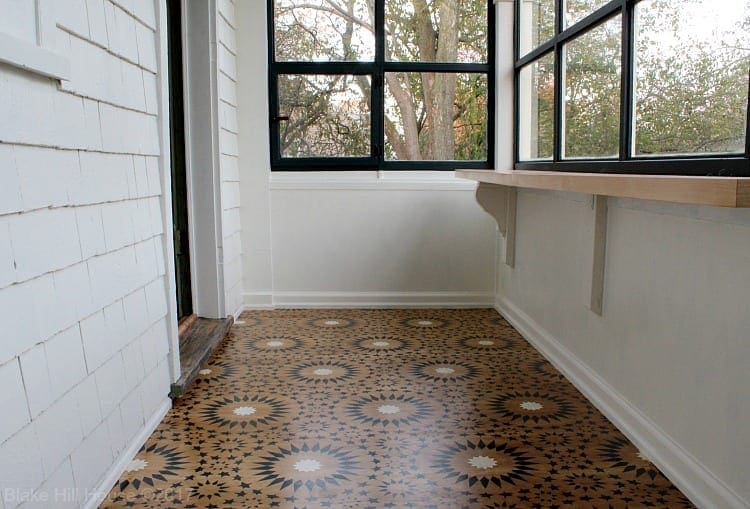
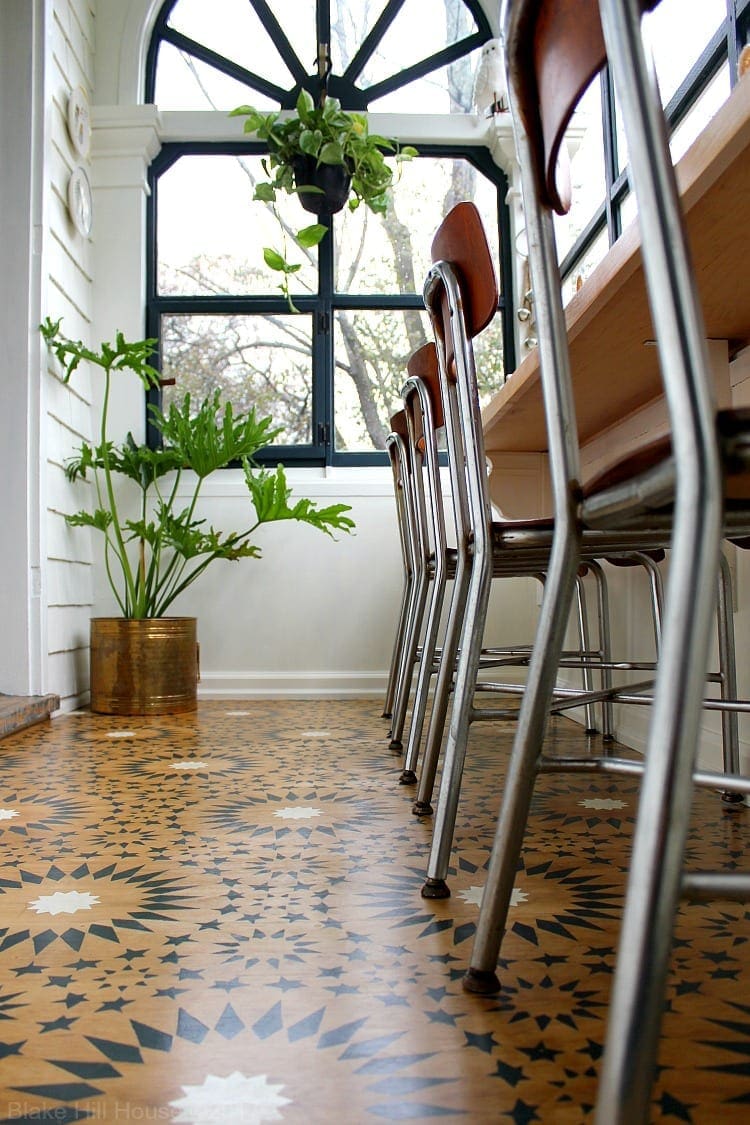
Feel free to leave comments and ask questions below, and be sure to pin this project for later.



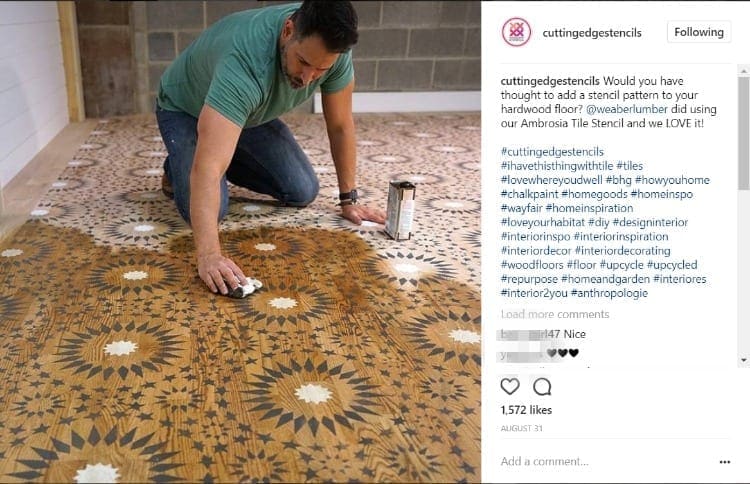
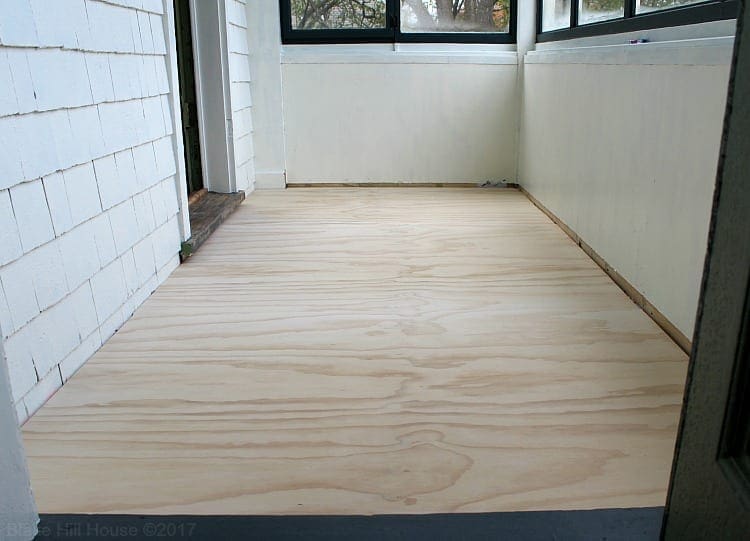
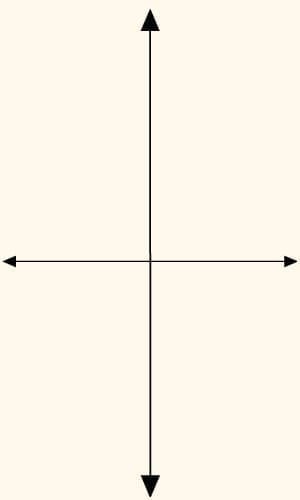
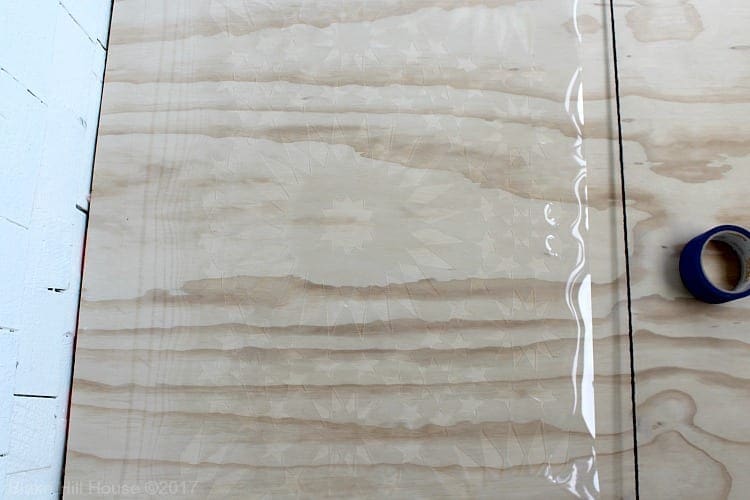
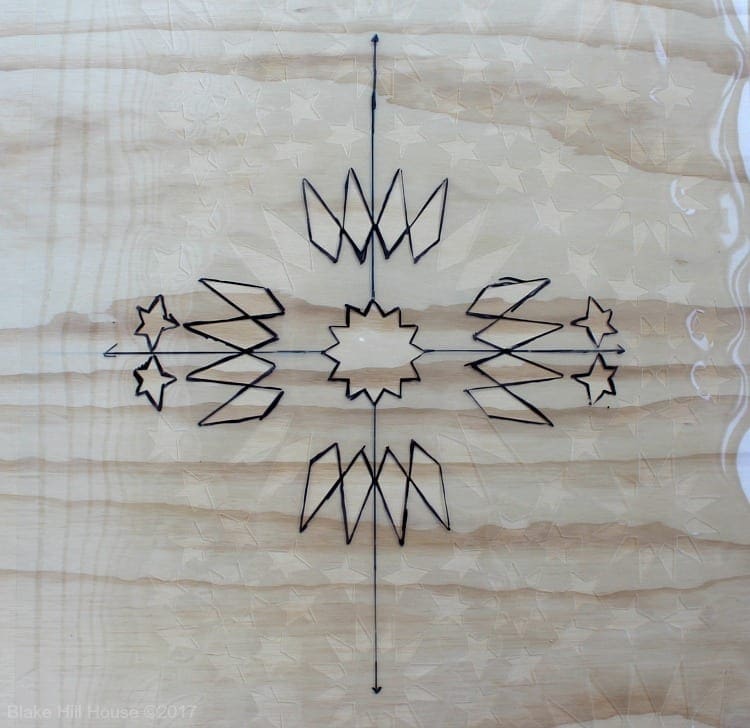
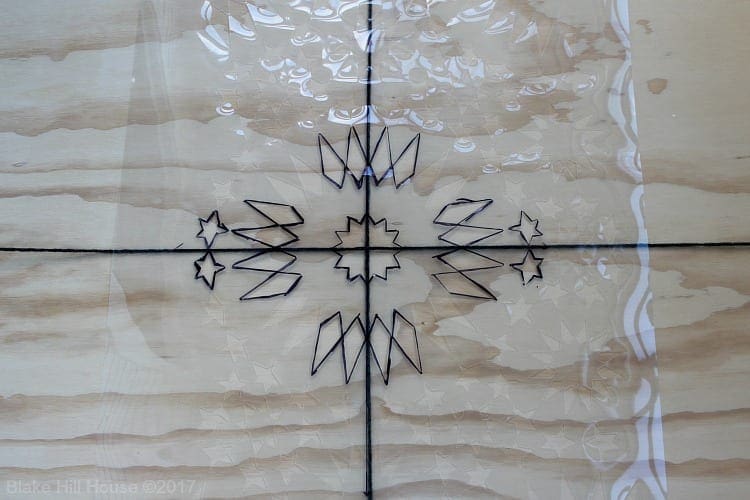

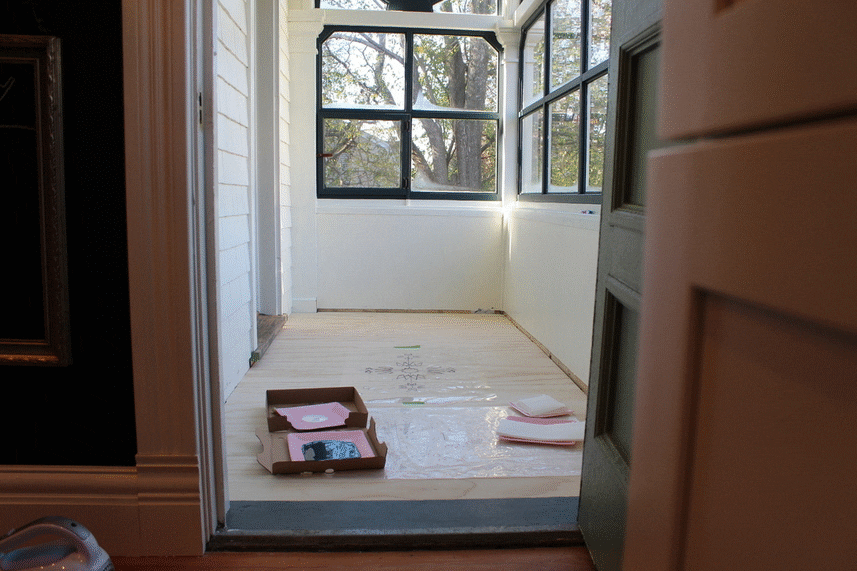
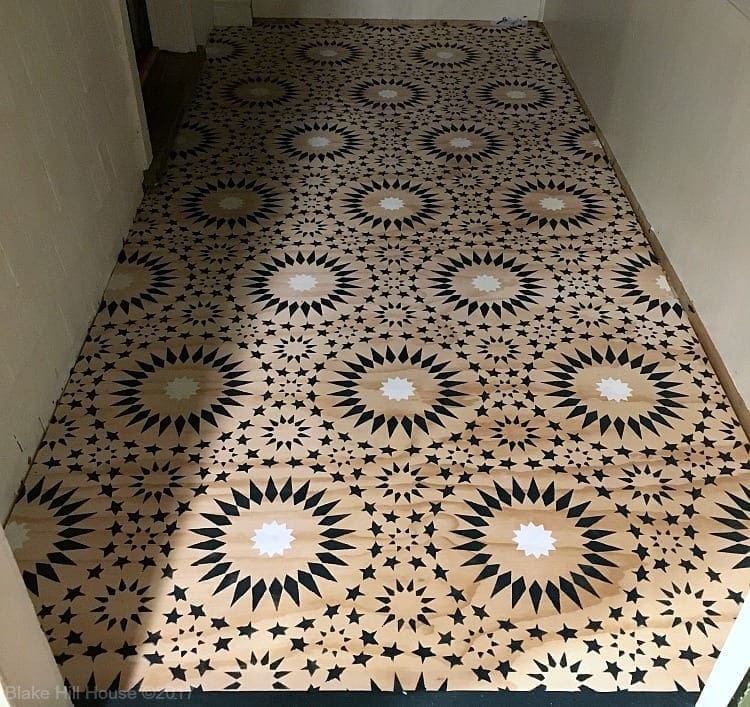
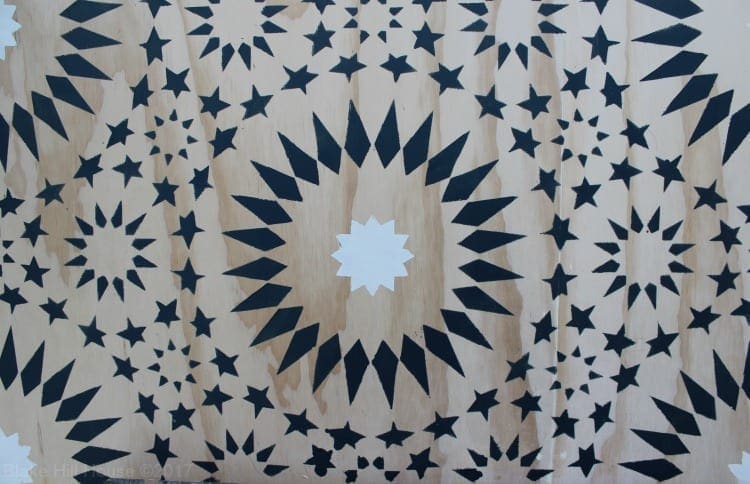
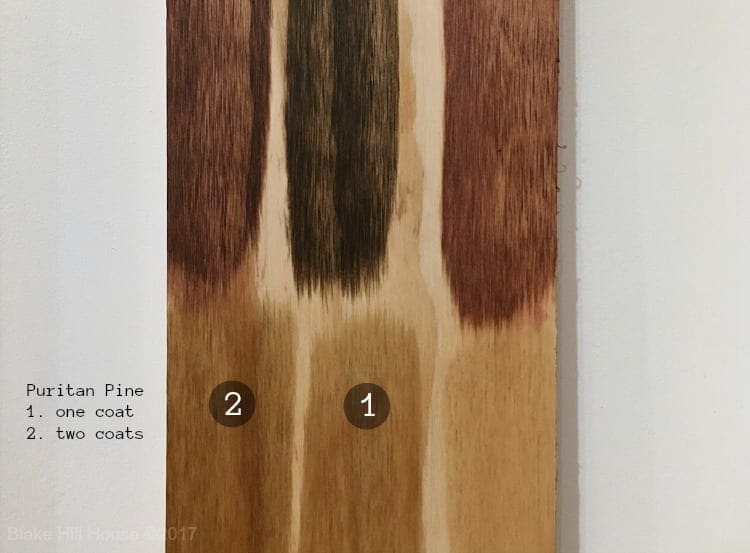
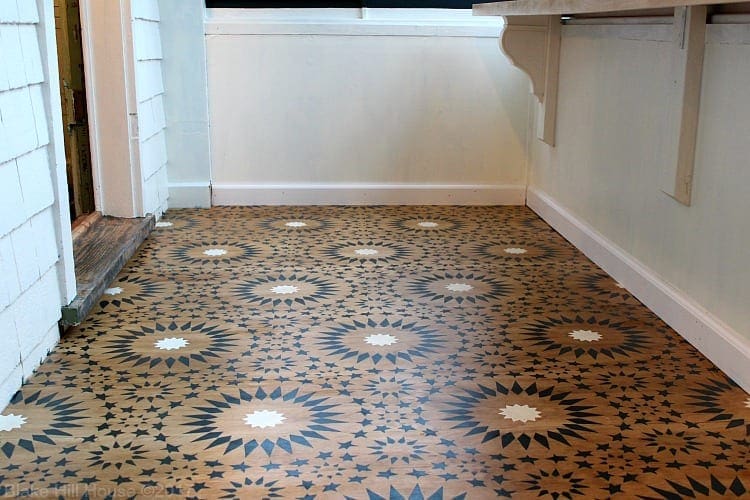

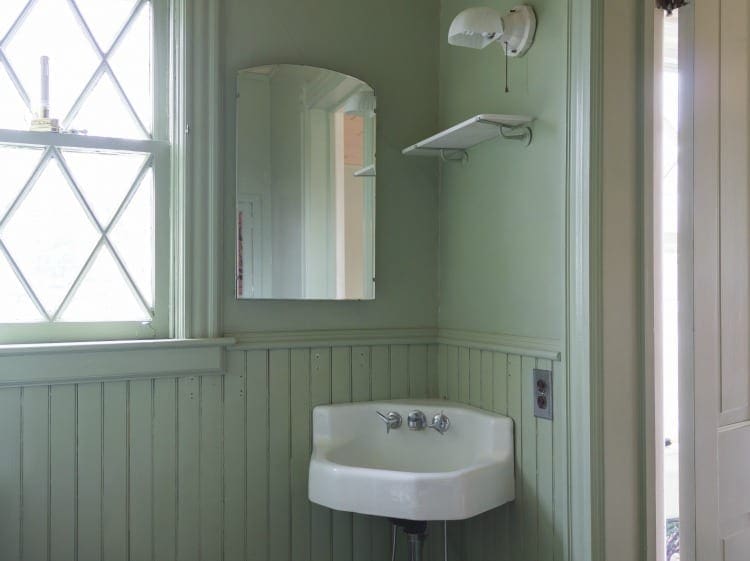
12 Comments
Kalila
What a great and detailed tutorial! Thanks for posting!
Stacy
Thank you, Kalila!
Vanessa
That is just so beautiful Stacy, you did a great job.
Stacy
Thank you, Vanessa!
Devyn
Gorgeous! I have done stenciling on walls, but not tackled a floor…. Yet.
Given that I am going to have a lot of floors to work on at the new (old) house, I see a stenciling project in our future.
Stacy
Thank you, Devyn. 🙂 I look forward to seeing a stencil project from you. I would love to see your spin on the idea since you have such a well-developed design aesthetic.
SH
Best use of a stencil on a floor ever, and the tutorial is especially useful with all of your extra tips. What became of the work on the laundry room door? I don’t remember you showing a final and I haven’t seen it in any photos. And is all that green paint now covered, at least on the first floor? And how charming a candle or two (battery/electric) would look in the window above that long table. Or maybe a pre-lit wreath.
Stacy
I was afraid someone would remember the laundry room door. Ha! Currently, I am still plugging away at removing the paint. Stripping woodwork is not my favorite job, and I ran out of time during the ORC. Bit-by-bit, I will finish it. 🙂
We still have green to eradicate. It’s an invasive species around here. Downstairs, the sunporch and the hall off the kitchen are still quite green. Also, the enclosed, outdoor porch on the front of the house is entirely green.
It’s funny that you mentioned battery-operated candles. I just put the winter candles in all of the windows, and I placed two in the breakfast nook.
Miss-Apple37
I’m saying it again, what a beautiful floor, beautiful pattern, and beautiful and inviting room.
Thumbs up!! and thank you for the tutorial!
Stacy
Thank you! I am so glad you like it.
Jennifer French-Glick
I know this post is a few years old–but I am looking to do this on our kitchen floor. Just wondering if there is a reason you didn’t stain first and then pain over it? Any ideas if I did it that way if it would still turn out? I am thinking of using chalk paint for the stencil.
Stacy
Hi Jennifer,
Wood stain is oil-based, and chalk paint and latex are water-based. You can paint over a stained surface, but you’d need to sand it first so the paint will adhere. For that reason, I’d paint it first. Hope that helps!